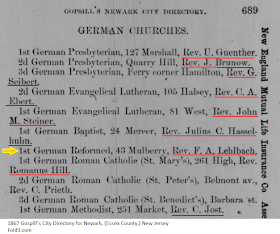Thank you to Tom and Kathryn Peters for indexing records of the First German Reformed Church in Newark, Essex County, New Jersey. This church was located on Mulberry Street. About 52,000 names are indexed, covering years 1847-1904. The index is housed at the Old Newark website. The actual records are held in Philadelphia, Pennsylvania at The Lutheran Archives Center.
This was no easy task. Look at this writing. I would not have been able to decipher most of it. Tom and Kathryn's efforts were a true labor of love.
 |
| Marriage record of Fidel Bossert and Regina Pfeiffer 24 October 1853 First German Reformed Church, Newark, New Jersey |
The index is divided by baptisms, marriages by groom, marriages by bride, and two sections of deaths/burials. Because of spelling inconsistencies and difficulties in deciphering the names, you will need to view similar nearby names as well as alternate spellings.
 |
| Groom index, First German Reformed Church Far easier to read than the original above |
 |
| Bride index, First German Reformed Church Marriage entry for my third great grandparents, David Uhl and Clara Patschke |
My 3rd great grandparents, David Uhl and Clara Patschke, were married at this church in 1865. The general rule with immigrants is that they did not come alone. Clara's parents were August Patschke and Wilhelmine. I do not know if they came to the United States. In this index, I quickly found a marriage record for Wilhelmine Auguste Patzschke, in 1860, contemporaneous with Clara Patschke. This is a great lead to explore if these two women were perhaps sisters.
| 1870 United States Federal Census Heinrich Wilhelm Heiner from the marriage index is spelled William Hyner in this census record. Newark, Essex County, New Jersey |
 |
| Gospill's City Directory for Newark, Essex County, New Jersey, 1867 The indexed records were from the First German Reformed at 43 Mulberry. Newark city directories are available at Fold3.com |















